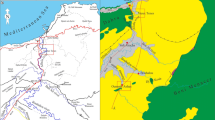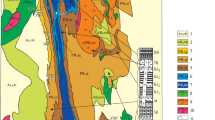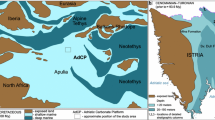Abstract
Numerous regular and irregularly shaped concretions were discovered in southern Croatia within the Upper Cretaceous carbonate deposits, which consist mostly of bioclastic wackestones and packstones. The size of the concretions varies from 2 to 25 cm in diameter for the regular, and up to 40 cm in length for the irregular ones. The concretions have different internal structures and compositions, which vary from those of the host rocks. Some concretions are entirely siliceous, while others exhibit alternating opal silica and carbonate-rich zones. Silica is derived from opal-A secreting marine biota, mostly sponges, whose spicules can be found within the concretions and in the surrounding limestones. The regular shape and alterations of zones are the result of the diffusive supply and fast “consummation” of silica at the growth site. Determined fossil community and bitumen found in the surrounding limestones indicate deposition in the oxygen-depleted deep-marine environment of the Adriatic Carbonate Platform, which belongs to the Sveti Duh Formation (latest Cenomanian–Early Turonian). The carbon isotope composition of the concretions corresponds to the globally known Cenomanian–Turonian ‘Oceanic Anoxic Event’ (OAE 2).






Similar content being viewed by others
References
Arthur MA, Schlanger SO, Jenkyns HC (1987) The Cenomanian/Turonian Oceanic Anoxic Event, II: paleoceanographic controls on organic matter production and preservation. In: Brooks J, Fleet AJ (eds) Marine petroleum source rocks. Geological Society Special Publication, no 26. Geological Society, London, pp 401–420
Badut D, Risacher F (1983) Authigenic smectite on diatom frustrules in Bolivian saline lakes. Geochim Cosmochim Ac 47:363–375
Bates RL, Jackson JA (1987) Glossary of geology, 3rd edn. American Geological Institute, Alexandria, p 788
Benton MJ, Csiki Z, Grigorescu D, Redelstorff R, Sander PM, Stein K, Weishampel DB (2010) Dinosaurs and the island rule: the dwarfed dinosaurs from Haţeg Island. Palaeogeogr Palaeoclimatol Paleoecol 293(3–4):438–454. doi:10.1016/j.palaeo.2010.01.026
Berner RA (1971) Principles of chemical sedimentology. McGraw-Hill Inc, New York, p 240
Berner RA, Westrich JT, Graber R, Smith J, Martens C (1978) Inhibition of aragonite precipitation for supersaturated sea-water: a laboratory and field study. Am J Sci 278:816–837
Bosellini A (2002) Dinosaurs “rewrite” the geodynamics of the eastern Mediterranean and paleogeography of the Apulia platform. Earth-Science Reviews 59:211–234
Bown PR, Young JR (1998) Techniques. In: Bown PR (ed) Calcareous nannofossil biostratigraphy. Chapman & Hall, Cambridge, pp 16–28
Channell JET, D’Argenio B, Horvath F (1979) Adria, the African promontory, in Mesozoic Mediterranean palaeogeography. Earth Sci Rev 15:213–292
Coccioni R, Luciani V (2005) Planktonic foraminifers across the Bonarelli Event (OAE2, latest Cenomanian): the Italian record. Palaeogeogr Palaeoclimatol Paleoecol 224:167–185. doi:10.1016/j.palaeo.2005.03.039
Coleman ML (1993) Microbial processes: controls on the shape and composition of carbonate concretions. Mar Geol 113:127–140
Coleman ML, Raiswell R (1995) Source of carbonate and origin of zonation in pyritiferous carbonate concretions: evaluation of a dynamic model. Am J Sci 295:282–308
Didyk BM, Simoneit BRT, Brassell SC, Eglinton G (1978) Organic geochemical indicators of palaeoenvironmental conditions of sedimentation. Nature 272:216–222
Dixit S, Van Cappelen P (2002) Surface chemistry and reactivity of biogenic silica. Geochim Cosmochim Ac 66:2559–2568
Fiket Ž, Alajbeg A, Strmić Palinkaš S, Tari-Kovačić V, Palinkaš L, Spangenberg J (2008) Organic geochemistry of Jurassic-Cretaceous source rocks and oil seeps from the profile across the Adriatic-Dinaric carbonate platform. Geol Carpath 59(3):225–236
Gebhardt H, Friedrich O, Schenk B, Fox L, Hart M, Wagreich M (2010) Paleoceanographic changes at the northern tethyan margin during the Cenomanian–Turonian Oceanic Anoxic Event (OAE-2). Mar Micropaleontol 77:25–45. doi:10.1016/j.marmicro.2010.07.002
Grimalt J, Albaigés J (1987) Sources and occurence of C12–C22 n-alkane distribution with even carbon-number preference in sedimentary environments. Geochim Cosmochim Ac 51:1379–1384
Gušić I, Jelaska V (1990) Upper Cretaceous stratigraphy of the island of Brač. Yugoslavian Academy of Science and Arts 69, Zagreb, p 160
Gušić J, Jelaska V (1993) Upper Cenomanian-Lower Turonian sea-level rise and its consequences on the Adriatic-Dinaric carbonate platform. Geol Rundsch 82:676–686
Jelaska V (2002) Carbonate Platforms of the External Dinarides. In: Vlahović I, Tišljar J (eds) Evolution of Depositional Environments from the Palaeozoic to the Quaternary in the Karst Dinarides and Pannonian Basin. 22nd International Association of Sedimentologists, Meeting of Sedimentology, Opatija, Field Trip Guidebook, pp 67–71
Jenkyns HC (1991) Impact of Cretaceous sea-level rise and anoxic events on the Mesozoic carbonate platform of Yugoslavia. Am Assoc Pet Geol Bull 75:1007–1017
Jerinić G, Jelaska V, Alajbeg A (1994) Upper Cretaceous organic-rich laminated limestones of the Adriatic Carbonate Platform, Island of Hvar, Croatia. AAPG Bulletin 78:1313–1321
Jurkovšek B, Toman M, Ogorelec B, Šribar L, Drobne K, Poljak M, Šribar Lj (1996) Geological map of the southern part of the Trieste-Komen plateau—Cretaceous and Paleogene carbonate rocks. Inštitut za geologijo, geotehniko in geofiziko, Ljubljana, p 143
Jurkovšek B, Cvetko Tešović B, Kolar-Jurkovšek T (2013) Geology of Kras (Geologija Krasa). Geological Survey of Slovenia, Ljubljana, p 205
Karakitsios V, Tsikos H, van Breugel Y, Koletti L, Sinninghe Damsté JS, Jenkyns HC (2007) First evidence for the Cenomanian–Turonian Oceanic Anoxic Event (OAE2, ‘Bonarelli’ event) from the Ionian Zone, western continental Greece. Int J Earth Sci (Geol Rundsch) 96:343–352. doi:10.1007/s00531-006-0096-4
Korbar T, Glumac B, Cvetko Tešović B, Cadieux SB (2012) Response of a carbonate platform to the Cenomanian–Turonian drowning and OAE2: a case study from the Adriatic platform (Dalmatia, Croatia). J Sediment Res 82:163–176. doi:10.2110/jsr.2012/17
Kröger N, Sumper M (2000) The biochemistry of silica formation in diatoms. In: Bäuerlein E (ed) Biomineralization—from biology to biotechnology and medical application. Wiley, Weinheim, pp 151–170
Lebedel V, Lezin C, Andreu B, Wallez M-J, El Ettachfini M, Riquier L (2013) Geochemical and palaeoecological record of the Cenomanian–Turonian Anoxic Event in the carbonate platform of the Preafrican Trough, Morocco. Palaeogeogr Palaeoclimatol Paleoecol 369:79–98. doi:10.1016/j.palaeo.2012.10.005
Lewin JC (1961) The dissolution of silica from diatom walls. Geochim Cosmochim Ac 21:182–198
Macsotay O, Erlich RN, Peraza T (2003) Sedimentary structures of the La Luna, Navay and Querecural Formations, Upper Cretaceous of Venezuela. Palaios 13:334–348
Maliński E, Gąsiewicz A, Witkowski A, Szafranek J, Pihlaja K, Oksman P, Wiinamäki K (2009) Biomarker features of sabkha-associated microbialites from the Zechstein Platy Dolomite (Upper Permian) of northern Poland. Palaeogeogr Palaeoclimatol Paleoecol 273:92–101. doi:10.1016/j.palaeo.2008.12.005
Marinčić S, Magaš N, Benček Đ (1977) Basic Geological Map of SFRY 1:100.000. Ploče Sheet. State Geological Institute, Beograd
McBride EF, Abdel-Wahab A, El-Younsy ARM (1999) Origin of spheroidal chert nodules, Drunka Formation (Lower Eocene). Egypt. Sedimentology 46:733–755
McCrea JM (1950) On the isotope chemistry of carbonates and paleotemperature scale. J Chem Phys 18:849–857
Pamić J, Gušić I, Jelaska V (1998) Geodynamic evolution of the Central Dinarides. Tectonophysics 297:251–268
Perch-Nielsen K (1985) Mesozoic calcareous nannofossils. In: Bolli HM, Saunders JB, Perch-Nielsen K (eds) Plankton stratigraphy. Cambridge University Press, Cambridge, pp 329–426
Peters KE, Walters CC, Moldowan JM (2005) The biomarker guide. Cambridge University Press, Cambridge, p 471
Raiswell R (1976) The microbiological formation of carbonate concretions in the Upper Lias of N.E. England. Chem Geol 18:227–244
Raiswell R (1988) Evidence for surface reaction-controlled growth of carbonate concretions in shales. Sedimentology 35:571–575
Raiswell R, Fisher QJ (2000) Mudrock-hosted carbonate concretions: a review of growth mechanisms and their influence on chemical and isotopic composition. J Geol Soc London 157:239–251
Schindler PW, Stumm W (1987) The surface chemistry of oxides, hydroxides, and oxide minerals. In: Stumm W (ed) Aquatic surface chemistry. Wiley-Interscience, New York, pp 83–110
Schlanger SO, Jenkyns HC (1976) Cretaceous oceanic anoxic events: causes and consequences. Geol Mijnbouw 55:179–184
Schlanger SO, Arthur MA, Jenkyns HC, Scholle PA (1987) The Cenomanian-Turonian Oceanic Anoxic Event, I. Stratigraphy and distribution of organic carbon-rich beds and the marine δ13C excursion. In: Brooks J, Fleet AJ (eds) Marine petroleum source rocks. Geological Society Special Publication, no 26. Geological Society, London, pp 371–399
Scopelliti G, Bellanca A, Coccioni R, Luciani V, Neri R, Baudin F, Chiari M, Marcucci M (2004) High-resolution geochemical and biotic records of the Tethyan ‘Bonarelli level’ (OAE2, latest Cenomanian) from the Calabianca-Guidaloca composite section, northwestern Sicily, Italy. Palaeogeogr Palaeoclimatol Paleoecol 208:293–317. doi:10.1016/j.palaeo.2004.03.012
Scopelliti G, Bellanca A, Neri R, Baudin F, Coccioni R (2006) Comparative high-resolution chemostratigraphy of the Bonarelli Level from the reference Bottaccione section (Umbria–Marche Apennines) and from an equivalent section in NW Sicily: consistent and contrasting responses to the OAE2. Chem Geol 228:266–285. doi:10.1016/j.chemgeo.2005.10.010
Scopelliti G, Bellanca A, Erba E, Jenkyns HC, Neri R, Tamagnini P, Luciani V, Masetti D (2008) Cenomanian–Turonian carbonate and organic-carbon isotope records, biostratigraphy and provenance of a key section in NE Sicily, Italy: palaeoceanographic and palaeogeographic implications. Palaeogeogr Palaeoclimatol Paleoecol 265:59–77. doi:10.1016/j.palaeo.2008.04.022
Steuber T, Korbar T, Jelaska V, Gušić I (2005) Strontium-isotope stratigraphy of Upper Cretaceous platform carbonates of the island of Brač (Adriatic Sea, Croatia): implications for global correlation of platform evolution and biostratigraphy. Cretac Res 26:741–756. doi:10.1016/j.cretres.2005.04.004
Stumm W (1993) Aquatic colloids as chemical reactants: surface structure and reactivity. Colloid Surf A73:1–18
Velić I, Vlahović I (eds) (2009) Explanatory notes for the geological map of the Republic of Croatia in 1:300.000 scale. Croatian Geol Institute, Zagreb, p 141
Velić I, Vlahović I, Matičec D (2002) Depositional sequences and palaeogeography of the Adriatic carbonate platform. Memorie della Società Geologica Italiana 57:141–151
Vlahović I, Tišljar J, Velić I, Matičec D (2005) Evolution of the Adriatic Carbonate Platform: palaeogeography, main events and depositional dynamics. Palaeogeogr Palaeoclimatol Paleoecol 220:333–360. doi:10.1016/j.palaeo.2005.01.011
Acknowledgments
We would like to thank the first finder of this phenomenon M. Martinović, writer and journalist J. Divić from Vrgorac, Pojezerje municipality area and Public Institution for Management of Protected Natural Values in the Dubrovnik-Neretva County for bringing us closer to this phenomenon. Concretions are preserved ex situ by the Croatian Ministry of Environmental and Nature protection (former Ministry of Culture) by the Nature Protection Directorate since 2011. For help in analytical process, we would like to thank D. Kukoč (for Radiolaria) and Š. Aščić (calcareous nannoplankton) from University of Zagreb, and T. Troskot-Čorbić from INA d.d. (for biomarkers). To the University of Barcelona, we are thankful for providing the laboratory for stable isotope analyses. We are grateful to R. Koščal (University of Zagreb) for preparation of graphics. For language improvements, we would like to thank Dr. Robyn Pickering (Faculty of Science, University of Cape Town, South Africa). This study was supported by the Croatian Ministry of Science, Education and Sports, project number 119-1951293-1162. We would like to thank Axel Munnecke, Editor-in-Chief, and two anonymous reviewers, for their constructive comments on the manuscript.
Author information
Authors and Affiliations
Corresponding author
Rights and permissions
About this article
Cite this article
Posilović, H., Fio Firi, K., Sremac, J. et al. Authigenic siliceous-carbonate concretions in Cenomanian–Turonian carbonates of southern Croatia; geochemical and biotic record. Facies 62, 28 (2016). https://doi.org/10.1007/s10347-016-0480-x
Received:
Accepted:
Published:
DOI: https://doi.org/10.1007/s10347-016-0480-x




